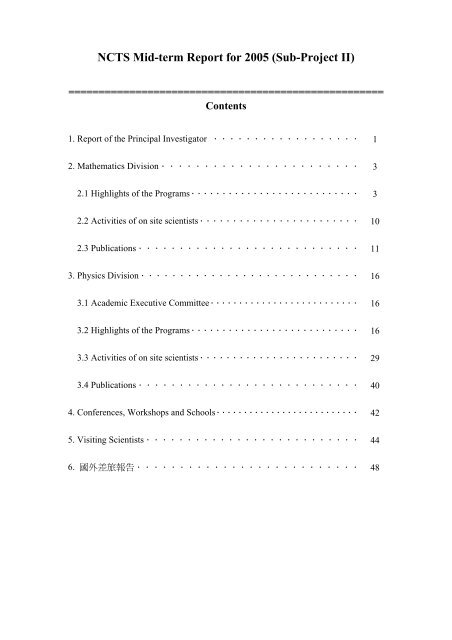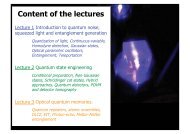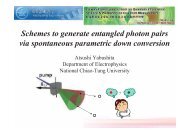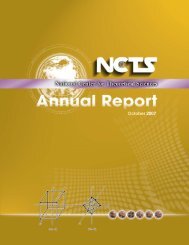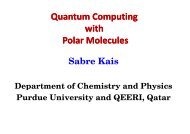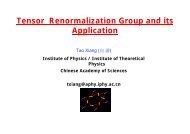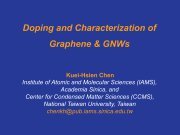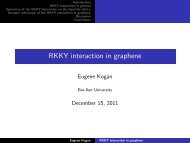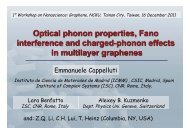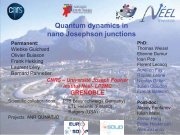NCTS Mid-term Report for 2005 (Sub-Project II) - 國家理論科學研究 ...
NCTS Mid-term Report for 2005 (Sub-Project II) - 國家理論科學研究 ...
NCTS Mid-term Report for 2005 (Sub-Project II) - 國家理論科學研究 ...
- TAGS
- ncts
- ncts.ncku.edu.tw
You also want an ePaper? Increase the reach of your titles
YUMPU automatically turns print PDFs into web optimized ePapers that Google loves.
2. Mathematics Division<br />
(Organizer: Prof. Soon-Yi Wu)<br />
Mathematics division of subproject <strong>II</strong> has 3 focused groups. Since the most active researchers in<br />
optimization are in southern Taiwan, optimization has been focused as an important research area in<br />
the subproject <strong>II</strong> of <strong>NCTS</strong>. Each focused group of mathematics division in subproject <strong>II</strong> has<br />
proceeded quite well. From April <strong>2005</strong>, the mathematics division of subproject <strong>II</strong> has held one<br />
international workshop on semi-infinite programming, and one workshop on graph colorings. One<br />
workshop on Functional Analysis is going to held in 2006. The National Cheng Kung University<br />
has offered two center scientists to promote the research in mathematics <strong>for</strong> subproject <strong>II</strong>.<br />
Three focused groups <strong>for</strong> the mathematics division of the sub-project <strong>II</strong> of <strong>NCTS</strong> are:<br />
Focused Group I: Algebra and Geometry<br />
Chief Coordinator <strong>for</strong> <strong>2005</strong>: Prof. Ying-Ji Hong<br />
Coordinator <strong>for</strong> Algebra: Prof. Chin-Hung Lam<br />
Coordinator <strong>for</strong> Geometry: Prof. Eugene Zhu Xia<br />
Focused Group <strong>II</strong>: Analysis and Application<br />
Chief Coordinator <strong>for</strong> <strong>2005</strong> Prof. Soon-Yi Wu<br />
Coordinator <strong>for</strong> Optimization: Prof. Soon-Yi Wu<br />
Coordinator <strong>for</strong> Analysis: Prof. Nagi-Ching Wong<br />
Focused Group <strong>II</strong>I: Applied Mathematics<br />
Chief Coordinator <strong>for</strong> <strong>2005</strong>: Prof. Xuding Zhu<br />
Coordinator <strong>for</strong> Discrete Mathematics: Prof. Xuding Zhu<br />
Coordinator <strong>for</strong> Differential Equations: Prof. Chi-Kun Lin<br />
The organizers, chief coordinators and coordinators are <strong>for</strong> helping to promote the activities of the<br />
Mathematics Division of the sub-project <strong>II</strong> of <strong>NCTS</strong>.<br />
2.1 Highlights of the Programs<br />
2.1.1 Focus Group: Algebra and Geometry<br />
A. Algebra Program<br />
Coordinator: Ching Hung Lam<br />
Our main goal is in <strong>2005</strong> is to improve the understanding between our members and to start<br />
some common research work.<br />
The activities <strong>for</strong> our program at <strong>2005</strong> are as follows:<br />
3
I. Weekly seminar<br />
It started from Feb <strong>2005</strong> and over 15 talks have been given by now. Topics covered include<br />
vertex operator algebra, quantum error correcting codes and symplectic geometry.<br />
<strong>II</strong>. Mini-course<br />
An 8-hour mini-course titled “Groups of even order” was given by Professor Koichiro Harada<br />
of Ohio State University. The main content is on Brauer-Fowler program on characterizing finite<br />
simple group by the centralizer of its involutions. Many new and old ideas were discussed.<br />
<strong>II</strong>I. Foreign Visitors<br />
There are 7 visitors from Jan <strong>2005</strong> – Sep <strong>2005</strong>. Their activities can be summarized as follows:<br />
Foreign Visitors Activities Date<br />
Koichiro Harada, • Discussion with C.H. Lam and W.F. Ke on 2/18- 3/15<br />
Ohio State<br />
research problems in finite group theory<br />
• An 8-hour mini-course “Groups of even order”<br />
and a talk “Group order <strong>for</strong>mula” were given.<br />
T. Arakawa, • Two talks on “Representations of W-algebras” 3/1- 3/14<br />
Nagaya<br />
were given.<br />
• Discussion with C.H. Lam and N. Lam on<br />
research problems in W-algebras and VOA<br />
Wei gen Yan, • A talk titled “Enumeration of Perfect Matchings of 6/22- 6/26<br />
Academia Sinica<br />
Graphs” was given<br />
• Discussion with C.H. Lam and W.F. Ke on graph<br />
and lattice theory<br />
Winnie Li,<br />
• A talk titled “Low density parity check codes” was 7/25- 7/26<br />
Penn State<br />
given<br />
Gernard Wendt,<br />
Linz<br />
Hubert Kiechle,<br />
Hamburg<br />
Christian Neumaier,<br />
Linz<br />
• Discussion with W.F. Ke on near ring and design 7/26-7/31<br />
• Discussion with W.F. Ke on group theory and near<br />
ring<br />
• A joint paper was written<br />
� A talk titled “Maximal subnear-rings of M0(G)<br />
and bijections generating M0(G) ” was given<br />
4<br />
7/28-8/9<br />
8/9-8/17<br />
IV. International Workshop<br />
On Mar <strong>2005</strong>, an international workshop on Algebra was held. The main theme was on ring<br />
theory and their applications. There were over 30 participants from 10 different countries, which<br />
included the winner of 1994 Fields Medal, Eflm Zemanolv.<br />
B. Geometry<br />
Coordinator: Eugene Xia<br />
Eugene Xia has been running weekly student seminars at <strong>NCTS</strong> South on Commutative Algebra,<br />
Riemann Surfaces and Discrete Groups. In May <strong>2005</strong>, <strong>NCTS</strong> South funded River Chiang to
attend a conference in Banff, Canada on Moment Maps in Various Geometries. <strong>NCTS</strong> South<br />
funded Eugene Xia <strong>for</strong> a trip to attend a Higgs bundle conference in Strasbourg, France and Basel,<br />
Switzerland in March <strong>2005</strong> and another trip to Shanghai, China to attend the Third Pacific Rim<br />
Conference on Mathematics during which he gave a presentation on the dynamics of the mapping<br />
class action on moduli spaces.<br />
Future Activities:<br />
Professor David Fisher of Indiana University plans to visit <strong>NCTS</strong> South in this academic year.<br />
He specializes in Lie Groups and Algebras. He plans to deliver lectures and hold discussion<br />
sessions at <strong>NCTS</strong>.<br />
We also plan to invite Professor J-K Chen (National Taiwan University) to give lectures at the<br />
National Cheng Kung University.<br />
There are also plans to invite Ser Tan Pew of National Singapore University during, Eugene<br />
Lerman of Australian National University, Viktor Ginzburg, of University of Cali<strong>for</strong>nia, Santa Cruz<br />
and Henrique Bursztyn of the Fields Institute.<br />
2.1.2 Focus Group: Analysis and Application<br />
A. Optimization<br />
Coordinator: Soon-Yi Wu<br />
In this year, our researches mainly focus on the semi-infinite optimization problems. We held an<br />
international workshop on semi-infinite programming from August 24-27. The topics of this<br />
workshop included the theory, algorithms, and the applications of the semi-infinite programming.<br />
We had four international famous professors as the plenary speakers <strong>for</strong> the workshop. The names<br />
and the speech times of the four professors are as follows:<br />
1. Prof. H. Th. Jongen (RWTH Aachen University, Germany)<br />
Speech Title: On Gradient Flows in Global Optimization<br />
2. Prof. E. Polak (University of Cali<strong>for</strong>nia, Berkeley)<br />
Speech Title: Reliability-Based Optimization Using Simple Average Approximations<br />
3. Prof. Jan-J. Rückmann (Universidad de lasAméricas)<br />
Speech Title: Kuhn-Tucker Constraint Qualifications in Generalized Semi-infinite Programming<br />
4. Prof. Kok Lay. Teo (Curtin University of Technology)<br />
Speech Title: Optmal Design of Complex FIR Filters with Arbitrary Magnitude and Group<br />
Delay Responses<br />
We invited ten professors from Hong Kong, USA, Spain, Germany and Netherlands <strong>for</strong> the<br />
workshop. A special issue will be published by the Journal of Computational and Applied<br />
Mathematics <strong>for</strong> the workshop. This workshop is a very important <strong>for</strong> people doing research on<br />
semi-infinite optimization. The workshop had 25 speech titles in total, and more than 50 people<br />
5
attendee the workshop.<br />
Prof. Jane Ye of Victoria University, Canada paid a visit to our center from 14 to 28 May, <strong>2005</strong>.<br />
During his visit, we had many discussions on generalizing semi-infinite programming problems.<br />
We have cooperated a manuscript entitled First Order Optimality Conditions <strong>for</strong> Generalized<br />
Semi-Infinite Programming Problems, which was submitted to SIAM Journal on Optimization. The<br />
titles of the four talks made by her are as the following:<br />
� Lecture 1:<br />
Mathematical Programs with Equilibrium Constraints, Bilevel Programming<br />
Problem and Their Applications<br />
� Lecture 2:<br />
Nonsmooth Optimization and Mathematical Programs with Equilibrium<br />
Constraints<br />
� Lecture 3: Necessary and Sufficient Optimality Conditions <strong>for</strong> Mathematical Programs with<br />
Equilibrium Constraints<br />
� Lecture 4: Quasiconvex Programming with Locally Starshaped Constraint Regions and its<br />
Application to Quasiconvex Program with Equilibrium Constraints<br />
From November <strong>2005</strong> to March 2006, we also plan to invite Prof. S. C. Fang, and Prof. James R.<br />
Wilson of North Carolina State University, USA, and Prof. David Yang Gao of Virginia Tech<br />
University, USA, to pay their visits to our center. We will plan our research to collaborate with<br />
them in Optimization. Optimization will be focused as an important research area in sub-project <strong>II</strong><br />
of <strong>NCTS</strong>.<br />
Speeches:<br />
� Prof. James R. Wilson<br />
Speech Title: Recent Advances in Output Analysis and Optimization <strong>for</strong> Discrete-Event<br />
Stochastic Simulation<br />
� Prof. David Yang Guo<br />
Speech Title: Complete Solutions and Extremality Criteria to Polynomial Optimization<br />
Problems<br />
B. Analysis<br />
Coordinator: Nagi-Ching Wong<br />
I. Highlights of the Program<br />
(1) In the first half of year <strong>2005</strong>, we have invited several analysts from aboard: Chi-Kueng Ng<br />
(China), Lisheng Shu (China), and Christian Neumaie (Austria). We will have more visitors in<br />
the second half year. The list includes Chris Phillips (USA), Nanjing Huang (China) and<br />
6
4. In the coming semester, we will have many visitors. Professor Pavol Hell from Simon Fracser<br />
University will visit us from Dec. 8 th to Dec. 13 th . From Dec. 9 th to December 13 th , Professor<br />
Claude Tardif from Royal Mount College will visit us. From Dec. 19 th to Dec. 23 rd , we will<br />
have two visitors: Professor Douglas West from Illinois University at Urbana-Champion and<br />
Professor Mike Albertson from Smith College. From Jan. 20 th to Feb. 20 th , Professor Daqing<br />
Yang from Fuzhou University and Professor Wensong Lin from South-East University will visit<br />
us <strong>for</strong> one month.<br />
5. Through the many visits of researchers from abroad last year, and through the seminars and<br />
workshops, collaboration among local researchers and between local researcher and visitors are<br />
enhanced. We had quite a few joint papers finished, and further collaborations are carrying on.<br />
B. Differential Equations<br />
Coordinator: Chi-kun Lin; Chun-Kong Law<br />
(I) Overview<br />
This year, most of our activities are on partial differential equations, in particular, evolution<br />
equations. The main activities are the minicourse on dimensional analysis and Differential<br />
Equations given by Chi-Kun Lin, one of the coordinator, and a series of talks on stability of<br />
traveling waves given by Ming Mei of Concordia University. The visit of Ming Mei reacts well<br />
with the visit of Xinfu Chen, who is also an expert of traveling waves.<br />
At both Cheng-Kung University and Sun Yat-sen University, we organize regular student’s<br />
seminars on differential equations.<br />
(<strong>II</strong>) Minicourse<br />
This year we organized one minicourse on Dimensional Analysis and Differential Equations,<br />
lectured by Chi-Kun Lin (National Cheng-Kung University). In this course, he introduced the<br />
concept of dimensional analysis and applied this idea to study different kinds of differential<br />
equations. In particular, we will focus on the Riesz potential, Hardy-Littlewood-Sobolev inequality,<br />
and the related Sobolev type inequalities which are important in differential equations. The course<br />
helped to establish the intuition in various problems involving scaling and dimensions, e.g.<br />
similarity reduction, fundamental solutions. Lots of examples were given. There were about 20<br />
researchers and students attending this mini-course. Detailed schedule is as follows:<br />
1. 04/22/<strong>2005</strong> 14:10-16:00 (Prof. Lin, Chi-Kun)<br />
Dimensional Analysis and Differential Equations (I)<br />
2. 04/29/<strong>2005</strong> 14:10-16:00 (Prof. Lin, Chi-Kun)<br />
Dimensional Analysis and Differential Equations (<strong>II</strong>)<br />
8
� Sally Shao (Cleveland State University, USA)<strong>2005</strong>/5<br />
1. Asymptotic and numerical solutions <strong>for</strong> diffusion models <strong>for</strong> risk reserves.<br />
2. The leaky-integrator recurrent neural dynamics, the state space search<br />
algorithm and their applications.<br />
� Ming Mei (Concordia University, Canada) <strong>2005</strong>/5<br />
1. Nonlinear stability of reaction diffusion equations.<br />
� William Ziemer (Indiana University, USA) <strong>2005</strong>/5<br />
1. The topological measure theoretical analysis of the support of a Sobolev<br />
function (The material is a power point file and can be downloaded from<br />
the website of CTS.)<br />
� Xinfu Chen (University of Pittsburgh) <strong>2005</strong>/6<br />
1. Traveling waves of bistable/monostable dynamics<br />
2. The Allen-Cahn diagram and phase transitions<br />
� Jun Zou (The Chinese University of Hong Kong) <strong>2005</strong>/10<br />
1. Iterative Methods <strong>for</strong> solving Saddle-Point Systems and Electromagnetic Problems<br />
2.2 Activities of on site scientists<br />
The following scholars who were supported by <strong>NCTS</strong> to give talks in the international conference<br />
or to visits some research institutes aboard to do research.<br />
Name Affiliation Time Visit<br />
River Meng-jung<br />
Chiang<br />
NCKU <strong>2005</strong>/05/21-<strong>2005</strong>/05/29 Moment maps in various geometries<br />
Soon-Yi Wu NCKU <strong>2005</strong>/05/13-<strong>2005</strong>/05/22 Visit Prof. Jane Ye (Vectoria Univ., Canada)<br />
Li-Da Tong NSYSU <strong>2005</strong>/06/22-<strong>2005</strong>/07/01 Conference on Graph Theory and<br />
Combinatorics<br />
Visit Prof. Grillakis and Machedon, Univ. of<br />
Yung-Fu Fang NCKU <strong>2005</strong>/06/24-<strong>2005</strong>/09/10<br />
Maryland<br />
<strong>2005</strong> International and the Third Cross-Striat<br />
Jiaojiao Wu NSYSU <strong>2005</strong>/06/26-<strong>2005</strong>/06/30 Conference on Graph Theory and<br />
Combinatorics<br />
10<br />
<strong>2005</strong> International and the Third Cross-Striat
Eugene Zhu Xia NCKU <strong>2005</strong>/08/17-<strong>2005</strong>/08/21 Third Pacific Rim Conference on Mathematics<br />
Jen-Chih Yao NSYSU <strong>2005</strong>/09/01-<strong>2005</strong>/09/08 Visit Prof. Franco Giannessi, Univ. of Pisa<br />
2.3 Publications<br />
� In Preparation<br />
1. K.W.Lih, C.Y.Lin and L.D.Tong, The cover problem of m-Mycielskian graphs and Kneser<br />
graphs, in preparation.<br />
2. Pavol Hell and Xuding Zhu, On the Rainbow Chromatic Number of Graphs, in preparation.<br />
3. Hong-Gwa Yeh, A note on circular colorings of edge-weighted directed graphs. In<br />
preparation.<br />
4. Yung-Chih Lu and Hong-Gwa Yeh, On proteins with unique optimal foldings in the 2D HP<br />
model. In preparation.<br />
5. Anthony T. Lau and Ngai-Ching Wong, “Disjointness and orthogonality preserving maps of<br />
Fourier algebras”, in preparation.<br />
� Preprints<br />
1. T. S. Chen and C.H. Lam, Extension of tensor products of unitary Virasoro vertex operator<br />
algebras, preprint.<br />
2. C. H. Lam and M. Miyamoto, Neimeier lattices, Coxeter elements and McKay E8 observation<br />
on the Monster simple group, preprint.<br />
3. W. F. Ke and H. Kiechle, Automorphisms of Certain Design Groups <strong>II</strong>, preprint.<br />
4. Li-Shu Chen, Jyh-Shyang Jeang and Ngai-Ching Wong, “Disjointness preserving shifts on<br />
C0(X)'s”, preprint.<br />
5. Lawrence G. Brown and Ngai-Ching Wong, “Left quotients of a C * -algebra, <strong>II</strong>I: Operators on<br />
left quotients”, preprint.<br />
6. Audrey Curnock, John Howroyd and Ngai-Ching Wong, “sometries of affine function spaces”,<br />
preprint.<br />
7. L. C. Zeng, S.Y. Wu and J.C. Yao(<strong>2005</strong>),Proximal Method <strong>for</strong> General Mixed Quasi<br />
Equilbrium Problems, preprint<br />
8. C. Ling, Q. Ni, L. Qi and S. Y. Wu (<strong>2005</strong>), A New Smoothing Newton-Type Algorithm <strong>for</strong><br />
Semi-Infinite Programming,preprint.<br />
9. M. Lopez, S. Y. Wu, C. Ling and L. Qi(<strong>2005</strong>), An Infinite-Dimensional Mathematical<br />
programming Approach to Separation in Lp(X,A,u), preprint.<br />
10. Xinfu Chen, Y.H. Cheng and C.K. Law, Reconstructing potentials using zeros of<br />
11
one eigenfunction, preprint.<br />
� <strong>Sub</strong>missions<br />
1. C.H. Lam, S. Sakuma and H. Yamauchi, Ising vectors and automorphism groups of commutant<br />
subalgebras related to root systems, submitted.<br />
2. Sandi Klavzar, Tsai-Lien Wong and Xuding Zhu, Distinguishing sets of graphs and<br />
group actions. <strong>Sub</strong>mitted.<br />
3. Sandi Klavzar, Tsai-Lien Wong and Xuding Zhu, Distinguishing labelings of group action on<br />
vector spaces and graphs. <strong>Sub</strong>mitted<br />
4. Daniel Kral, Li-Da Tong and Xuding Zhu, Upper Hamilton numbers and Hamilton spectra of<br />
graphs, <strong>Sub</strong>mitted.<br />
5. Daphne Liu and Xuding Zhu, Fractional Chromatic Number of Distance Graphs Generated by<br />
Two-Interval Sets. <strong>Sub</strong>mitted.<br />
6. Yin-Fen Lin and Ngai-Ching Wong, “Compact disjointness preserving maps of continuous<br />
functions”, submitted to Studia Math.<br />
7. Jung-Hui Liu, Ngai-Ching Wong and Jen-Chih Yao, “Local automorphisms of operator<br />
algebras”, submitted to Illinois J. Math.<br />
8. Man-Chung Ng and Ngai-Ching Wong, “A non-compact approach to the duality between prior<br />
beliefs and trading demands”, submitted to J. Economics Theory.<br />
9. S. J. Li,S. Y. Wu, K. L. Teo and X. Q. Yang and S. Y. Wu, Robust Envelop-constrained Filter<br />
with Orthonormal Bases and Semi-Definite and Semi-Infinite Programming, submitted to<br />
Optimization and Engineering.<br />
10. S.C. Fang, S. Y. Wu, and S. Ilker Birbil, Solving Variational Inequalities Defined on a Domain<br />
with Infinitely Many Linear Constraints, submitted to Computational Optimization and<br />
Aplications.<br />
11. S. Y. Chen and S. Y. Wu , Algorithms <strong>for</strong> Semi-infinite Transportation Problem, submitted to<br />
Journal of Optimization Theory and Applications.<br />
12. J. Ye and S. Y. Wu (<strong>2005</strong>), First Order Optimality Conditions <strong>for</strong> Generalized Semi-Infinite<br />
Programming Problems, <strong>Sub</strong>mitted to SIAM Journal of Optimization.<br />
13. C.N. Chen, L.F. Cheung, Y.S. Choi and C.K. Law, Integrability of rotationally symmetric<br />
n-harmonic maps, submitted.<br />
12
� Under Revision<br />
1. Gerard J. Chang and Li-Da Tong, The Hamiltonian Property of Multi-loop Network, under<br />
revision.<br />
2. S. J. Li, S. Y. Wu, K. L. Teo and X. Q. Yang, A solution Method <strong>for</strong> Generalized Semi-Infinite<br />
Programming, submitted to Optimization Methods and Software.<br />
� Accepted Papers<br />
1. K.W. Lih, C.Y. Lin and L.D. Tong, On an interpolation property of outerplanar graph, Discrete<br />
Applied Math., accepted.<br />
2. Sandi Klavzar and Xuding Zhu, Cartesian powers can be distinguished by t wo labels. .<br />
European Journal of Combinatorics, to appear.<br />
3. Ngai-ChingWong, Triple homomorphisms of operators algebras, Southeast Asian Bulletin of<br />
Math., to appear.<br />
4. Lu-Chuan Zeng, Ngai-Ching Wong, and Jen-Chih Yao, Strong convergence theorems <strong>for</strong><br />
strictly pseudocontractive mappings of Browder-Petryshyn type, Taiwanese J. Math., to appear.<br />
5. Lai-Jiu Lin, Ngai-Ching Wong and Zenn-Tsuen Yu, “Continuous selections and fixed points of<br />
multi-valued mappings on non-compact or non-metrizable spaces”, Proc. Amer. Math. Soc., to<br />
appear.<br />
6. Lu-Chuan Zeng, Ngai-Ching Wong and Jen-Chih Yao, “On the convergence analysis of<br />
modified hybrid steepest-descent methods with variable parameters <strong>for</strong> variational inequalities”,<br />
J. Optimization Theory and Application, to appear.<br />
7. Lu-Chuan Zeng, Ngai-Ching Wong and Jen-Chih Yao, “Convergence of hybrid<br />
steepest-descent methods <strong>for</strong> generalized variational inequalities”, Acta Math Sinica (english<br />
series), to appear.<br />
8. Yen-Cherng Lin, Ngai-ChingWong and Jen-Chih Yao, “Strong Convergence Theorems of<br />
Ishikawa Iteration Process With Errors For Fixed points of Lipschitz Continuous Mappings in<br />
Banach Spaces”, Taiwanese J. Math., to appear.<br />
9. L. C. Zeng, G. M. Lee and Ngai-Ching Wong, “Ishikawa Iteration with Errors <strong>for</strong><br />
Approximating Fixed Points of Strictly Pseudocontractive Mappings of Browder-Petryshyn<br />
Type”, Taiwanese J. Math., to appear.<br />
10. Ngai-Ching Wong, “The triangle of operators, topologies and bornologies”, in the Proceedings<br />
of the 2nd International Congress of Chinese Mathematicans, to appear.<br />
11. Jung-Hui Liu and Ngai-Ching Wong, “2-Local automorphisms of operator algebras”, J. Math.<br />
13
Anal. Appl., to appear.<br />
12. S. Y. Wu, D. H. Li, L. Qi and G. Zhou(<strong>2005</strong>), An Iterative Method <strong>for</strong> Solving KKT System of<br />
the Semi-Infinite Programming, to appear in Optimization Methods and Software.<br />
13. C. Ling, L. Qi, G. Zhou and S. Y. Wu(<strong>2005</strong>), Global Convergence of a Robust Smooothing<br />
SQP Method <strong>for</strong> Semi-Infinite Programming, to appear in Journal of Optimization Theory and<br />
Applications.<br />
14. S. J. Li. K. L. Teo, X. Q. Yang and S. Y. Wu(<strong>2005</strong>), Gap Functions and Existence of Solutions<br />
to Generalized Vector Quasi-Equilibrium Problems, to appear in Journal of Global<br />
Optimization.<br />
15. S. J. Li, S S. Y. Wu, X. Q. Yang and K. L. Teo (<strong>2005</strong>), A Relaxed Cutting Plane Method <strong>for</strong><br />
Semi-Infinite Programming, to appear in Journal of Computational and Applied Mathematics .<br />
16. L. C. Zeng, Q. H. Ansari and S. Y. Wu, Strong Convergence Theorems of Relaxed Hybrid<br />
Steepest-Descent Methods <strong>for</strong> Variational Inequalities, to appear in Taiwanese Journal of<br />
Mathematics.<br />
17. Y.H. Cheng and C. K. Law, On the quasinodal map <strong>for</strong> the Sturm-Liouville operator, Proc.<br />
Royal Soc. Edinburgh, series A, to appear (<strong>2005</strong>). (SCI)<br />
18. Z.C. Li, C.S. Huang and R.C.D. Chen, Interior boundary conditions in the Schwarz<br />
alternating method <strong>for</strong> the Trefftz method, Engineering Analysis with Boundary elements, to<br />
appear (<strong>2005</strong>). (SCIE)<br />
19. H.Y. Hu, Z.C. Li and A.H.D. Cheng, Radial basis collocation methods <strong>for</strong> elliptic boundary<br />
value problems, Inter. J. Computers & Mathematics with Application, to appear (<strong>2005</strong>).<br />
(SCI)<br />
20. Z.C. Li, Y.L. Chan, G.G. Georgiou and X. Xenophotos, Special boundary approximation<br />
methods <strong>for</strong> Laplace equation problems with boundary singularities (application to Motz<br />
problem), Inter. J. Computers & Mathematics with Applications, to appear (<strong>2005</strong>). (SCI)<br />
21. H.T. Huang, Z.C. Li and A. Zhou, New error estimates of biquadratic Lagrange elements <strong>for</strong><br />
Poisson’s equation, accepted by Applied Numerical Mathematics, to appear (<strong>2005</strong>). (SCI)<br />
22. H.Y. Hu and Z.C. Li, Collocation methods <strong>for</strong> Poisson’s equation, Computer Methods in<br />
Applied Mechanics and Engineering, to appear (<strong>2005</strong>). (SCI)<br />
23. H.T. Huang and Z.C. Li, Effective condition number and superconvergence of the Trefftz<br />
method coupled with high order FEM <strong>for</strong> singularity problems, Engineering Analysis with<br />
Boundary elements, to appear (<strong>2005</strong>). (SCI)<br />
14
24. Z.C. Li, Algorithms <strong>for</strong> curve image under geometric trans<strong>for</strong>mations, Inter. J. In<strong>for</strong>mation, to<br />
appear (<strong>2005</strong>).<br />
� Papers Appeared<br />
1. C.H. Lam, H. Yamada, and H. Yamauchi, Mckay's observation and vertex operator algebras<br />
generated by two con<strong>for</strong>mal vectors of central charge 1/2, Intern. Math. Res. Paper, Volume<br />
<strong>2005</strong>, Issue 3, pp. 117 –182.<br />
2. Yin-Fen Lin and Ngai-Ching Wong, “Power compact disjointness preserving maps of<br />
continuous function spaces”, Bulletin of the Irish Mathematical Society, 55 (<strong>2005</strong>), 7–14.<br />
3. Y.H. Cheng, C.T. Shieh and C.K. Law, A vectorial inverse nodal problem, Proc. Amer.<br />
Math. Soc., Vol. 133, no.5, 1475-1484 (<strong>2005</strong>). (SCI)<br />
4. C.C. Chen, C.K. Law and F.Y. Sing, Optimal lower estimates <strong>for</strong> eigenvalue ratios of<br />
Schrodinger operators and vibrating strings, Taiwanese J. Math., Vol. 9, no.2, 175-185 (<strong>2005</strong>).<br />
(SCI)<br />
5. Z.C. Li, T.T. Lu, H.Y. Hu and A.H.D. Cheng, Particular solutions of Laplace’s equations on<br />
polygons and new models involving mild singularities, Engineering Analysis with Boundary<br />
Elements, Vol. 29 (1), 59-75 (<strong>2005</strong>). (SCIE)<br />
6. T.T. Lu and Z.C. Li, The cracked-beam problem solved by the boundary approximation<br />
method, Applied Mathematics Letters, Vol. 18 (1) 11-16 (<strong>2005</strong>). (SCI)<br />
15
Quantum physics, in<strong>for</strong>mation theory, and computer science are among the crowning intellectual<br />
achievements of the past century.<br />
The QIS focus program supported by National Center <strong>for</strong> Theoretical Science will build a<br />
plat<strong>for</strong>m of communication <strong>for</strong> researchers in this area. We have established associations and<br />
cooperation other researchers all over Taiwan; and will seek to establish links and exchanges other<br />
QIS researchers and activities worldwide. We believe this national program will be joined by many<br />
other local researchers in the near future. Although Taiwan has yet to make its mark on the subject<br />
internationally, many local researchers are already working on areas bordering on QIS, both<br />
theoretically and experimentally. We believe with strong support and encouragement; with the<br />
appropriate alignment of theoretical and experimental personnel, by learning from others, by<br />
exchanging scholars and in<strong>for</strong>mation with other institutions; and last but not least - by closely<br />
integrating QIS research with Taiwan’s commitment, we will be able to ramp up quickly to realize<br />
Taiwan’s potential in QIS, and to compete on equal footing with other nations in this exciting<br />
frontier.<br />
To achieve the above objectives, a program committee has been <strong>for</strong>med <strong>for</strong> the year of <strong>2005</strong>. Its<br />
mission includes selection of research topics, budget allocation, and invitation of long-<strong>term</strong> visitors<br />
and recommendation of candidates <strong>for</strong> exchange programs. The current members and their<br />
specializations are:<br />
Wei-Min Zhang (NCKU), quantum dot quantum computers (Theory)<br />
Hsi-Sheng. Goan (NTU), silicon-based quantum computer, decoherence (Theory)<br />
Chih Long Chou (CYCU), quantum communication (Theory)<br />
Pochung Chen (NTHU), quantum dot quantum computer (Theory)<br />
Der-San Chuu (NCTU), cavity QED, quantum dot (Theory & Experiment)<br />
Zheng-Yao Su (NCHC), quantum algorithms (Theory)<br />
Chopin Soo (NCKU) quantum entanglement, fundamental quantum physics (Theory)<br />
The committee meeting will be held once every two month. The first committe meeting was in<br />
April at National Cheng Kung University. The Second committe meeting held in June at National<br />
Taiwan University.<br />
Outlines of Activities<br />
With the budget of about 2 million TWD <strong>for</strong> the academic year 2004-<strong>2005</strong>, the committee has<br />
decided to support <strong>for</strong> a post-doc researching position. This position had granted to Dr. Lee,<br />
Min-Chung. He is current working on the theory of decoherence process. The budge <strong>for</strong> this hiring<br />
is about 850,000 TWD.<br />
In order to provide a communication plat<strong>for</strong>m from QIS researchers in Taiwan, we plan to<br />
17
have a small workshop every two months. The first workshop was held on June 10 and 11 at<br />
national Taiwan University, hosted by Hsi-Sheng Goan. The second workshop was held in<br />
September 23 at National Tsing Hwa University. Pochung Chen and Zeng-Yao Su hosted this<br />
workshop.<br />
We are planning a QIS winter school in December <strong>2005</strong>. The list of candidates of inviting speakers<br />
including Prof. Lu Jeu Sham (UC San Diego, USA), Prof. Hoi-Kwong Lo (U. Toronto, Canada),<br />
Prof. Bei Lok Hu (U. Maryland, USA), Prof Artur Ekert (NUS, Singapore) and Prof. Francesco<br />
Petruccione (South Africa).<br />
Progress<br />
1. The first workshop was held on Jun 10 – 11 at National Taiwan University hosted by Hsi-Sheng<br />
Goan. The inviting speakers and their topics were:<br />
� Prof. Todd A. Brun (University of Southern Cali<strong>for</strong>nia)<br />
"Weak Quantum Measurements Are Universal"<br />
� Prof. Bei-Lok Hu (University of Maryland)<br />
"Non-Markovian Quantum Decoherence and Error Correction -- the regime which<br />
really counts <strong>for</strong> quantum computer designs"<br />
� Dr. Chung-Hsien Chou (Academic Sinica)<br />
"Non-Markovian Dynamics of Quantum Decoherence and Disentanglement"<br />
The following shows the speakers and part of the participants of this workshop.<br />
2. The second workshop was held on September 23 at National Tsing Hua University hosted by<br />
Pochung Chen and Zeng-Yao Su. The inviting speakers and their topics were:<br />
18
<strong>2005</strong>/09/19<br />
Prof. Pi-Gang Luan<br />
Institute of Optical Sciences,<br />
National Central University<br />
21<br />
Anomalous refraction in photonic<br />
crystals<br />
<strong>2005</strong>/09/21 Quantum Dots Group Meeting The latest experimental progress<br />
<strong>2005</strong>/09/26<br />
<strong>2005</strong>/10/03<br />
<strong>2005</strong>/10/13<br />
Prof. Wei-Min Zhang<br />
Department of Physics, NCKU<br />
Dr. Ying-Cheng Chen<br />
Institute of Atomic and Molecular<br />
Sciences, Academia Sinica<br />
Prof. Jaw-Shen Tsai<br />
Laboratory Head, Macroscopic<br />
Quantum Coherence Lab, Riken;<br />
& Research Fellow, Fundamental<br />
Research Laboratories, NEC,<br />
Japan<br />
Free Spin Quantum Computer<br />
Exploring the ultracold world<br />
Josephson Multi-Qubit Systems<br />
4. “Quantum Decoherence in Solid-state qubits” Reseach report by Ming Tsung Lee<br />
My research interests are primarily in the related field of quantum in<strong>for</strong>mation physics<br />
containing: Physical realizations of quantum in<strong>for</strong>mation, mechanism and control of quantum<br />
decoherence, and quantum measurement. This field has attracted much attention <strong>for</strong> practical<br />
applications in quantum in<strong>for</strong>mation science in recent years. Quantum decoherence is mainly<br />
induced by the interaction of a microscopic system coupled with its environment. The non-unitary<br />
evolution of the system destroys the purity of quantum states, quantum interference and quantum<br />
entanglement, and leads to in<strong>for</strong>mation loss toward the environment.<br />
Recently, some investigations of quantum decoherence have been focused on the decoherence<br />
induced by quantum measurements and the controls of quantum decoherence. For the<br />
implementation of realistic quantum in<strong>for</strong>mation processors, these studies become the most<br />
champion works in the field. In the solid-state quantum computer with charge qubits, qubit<br />
measurements can be realized by the charge qubit coupled with sensitive electrometers such as<br />
quantum point contacts (QPC) and single-electron transistors. I have been researching on the<br />
quantum measurement of a single-electron in coupled quantum dots (a charge qubit) by a QPC and<br />
the dynamical non-equilibrium effect of the QPC on the decoherence of the charge qubit.<br />
To study the quantum decoherence induced by quantum measurement, the condition of the<br />
perfect heat bath is usually introduced to simplify the problem in literatures. However, practically,<br />
this condition is not guaranteed at mesoscopic scale. The non-equilibrium effect from the heat bath<br />
should be taken into account. For the QPC, the non-equilibrium effect could be induced by
the electron accumulation (EA) in reservoirs. I have developed a perturbation scheme to take the<br />
EA effect into account [1]. The character of the EA in <strong>term</strong>s of the analytic EA number and the<br />
quantum decoherence of the measured single electron in coupled dots under the EA effect are<br />
studied in the framework. The theory shows that the EA can induce an extra relaxation to the qubit<br />
decoherence. However, the influence of the EA effect to the decoherence rate depends on the<br />
bias-assistance in the QPC.<br />
� 2006 Workplan<br />
1. 2006 QIS workshop:<br />
National-wide every two-year QIS workshop will be held by QIS focus group in 2006.<br />
Estimated participants are around 150 people.<br />
2. International and national exchange visitors on QIS.<br />
a. Short-<strong>term</strong> (within a week) international visitors: 4 to 6 people<br />
b. Summer (two-months) visitors in <strong>NCTS</strong>/south<br />
c. Support students and Postdocs to attend the second Asia-pacific conference on QIS held in<br />
Korean in 2006<br />
3. Postdoc <strong>for</strong> QIS<br />
Dr. Ming-Tsung Lee, will be hired continuously as a <strong>NCTS</strong>/south Postdoc <strong>for</strong> one more year.<br />
His research field: quantum decoherence and quantum dot quantum computer. We also hope to<br />
recruit one more postdoc. to strengthen and cultivate the young scientist in this field.<br />
4. Participants (anyone else who is working on QIS and would like to join the group is very<br />
welcome)<br />
Chia Chu Chen (NCKU), quantum optics and photon entanglement (Th.)<br />
Ching Cheng (NCKU), quantum dot quantum computer (Th.)<br />
Chien-Er Lee (NCKU), quantum teleportation (Th.)<br />
Chuan Pu Liu (NCKU), quantum dot quantum computer (Exp.)<br />
Yan-Ten Lu (NCKU), quantum dot quantum computer (Th.)<br />
Chopin Soo (NCKU), quantum entanglement, quantum dots (Th.)<br />
Chin Chun Tsai (NCKU), photon entanglement and optical lattice (Exp.)<br />
Wei-Min Zhang (NCKU), quantum dot quantum computers (Th.)<br />
Chi-Yee Cheung (AS), quantum cryptography (Th)<br />
Chii-Dong Chen (AS), quantum single electron transistors (Exp.)<br />
Pochung Chen (NTHU), quantum dot quantum computer (Th.)<br />
Yueh Nan Chen (NCTU) cavity QED, quantum dot quantum computer (Th.)<br />
Der-San Chuu (NCTU) cavity QED, quantum dot quantum computer (Th. & Exp.)<br />
Jin-Yuan Hsieh (MHUST)Quantum algorithms (Th)<br />
22
Li-Yi Hsu (CYCU), quantum communication (Th.)<br />
Chih Long Chou (CYCU), quantum communication (Th.)<br />
Zheng-Yao Su (NCHP), quantum algorithms (Th.)<br />
Hai-Sheng. Goan (NTU), silicon-based quantum computer, decoherence (Th.)<br />
Waston Kuo (NCCU), Superconducting quantum computer (Exp.)<br />
Dian Jiun Han (CCU), Optical Lattice quantum computer (Exp.)<br />
Note: 1) weekly seminars mainly <strong>for</strong> two groups located in south and north, respectively.<br />
2).monthly meetings and mini-workshops are national-wide. All participants have the<br />
responsibility to organize these activities.<br />
3.2.2 Focused Group: Low-Dimensional Systems and Nanostructures<br />
Committee members: Ching Cheng (Nat’l Cheng Kung Univ., chairman), Min-Fa Lin (Nat’l<br />
Cheng Kung Univ.), Tsan-Chuen Leung (Nat’l Chung Cheng Univ.), Shiow-Fon Tsay (Nat’l<br />
Sun Yat-sen Univ.)<br />
Objectives<br />
The main purpose of the focus group on low-dimensional systems and nanostructures is to<br />
promote interaction and collaboration among members (as well as their graduate students and<br />
postdoctors) of this group towards possible integration of the available research methods as well<br />
as manpower in exploring low-dimensional systems and nanostructures. In spite of a great<br />
diversity of the systems covered by the low-dimensional systems and nanostructures, the<br />
focuses of the group are mainly on, but not restricted to, the physical properties of<br />
nanostructures, e.g. the carbon related nanostructures, and their confinements in a 2D potential,<br />
e.g. the assembly of nanoparticles on surfaces or trapped atoms in a 2D optical lattice. The<br />
<strong>for</strong>mation of this focus group was especially urged by the previously already existing<br />
collaborations between some participants of the group to activate a wider and stronger scope of<br />
interactions through both regular and well-designed meetings.<br />
Outlines of activities<br />
The supported budget <strong>for</strong> this focus group is 500K TWD. As this is the first year of the<br />
focus group, some of the activities are designed to promote interactions between the researchers<br />
in the field. The activities held by the group include 1) either regular talks or a series of talks<br />
on a focused topic 2) study-group meetings on specialized topics 3) mini-school 4) workshops 5)<br />
short-<strong>term</strong> visitors. The subjects of the workshops and mini-school have attracted many more<br />
interested participants than we originally expected. The group members benefit much from the<br />
enthusiastic discussions in the meetings. Due to the limit on both time and budget, extension<br />
of the interactions and possible collaboration with distinguished overseas groups will be one of<br />
the objectives of the group in the next year. The activities are summarized in the following:<br />
23
Short-<strong>term</strong> visitors<br />
Four short-<strong>term</strong> visitors to the <strong>NCTS</strong>(South) were offered to promote interactions and<br />
collaboration between members of the group. Two are in the field of nanocarbon systems, i.e.<br />
Cheng-Peng Chang of Tainan Woman’s College of Arts & Technology and Rong-Bin Chen of<br />
National Kaohsiung Marine Univ., and the other two are in the field of quantum transport theory<br />
<strong>for</strong> nanosystems, i.e. Yueh-Nan Chen of Nat’l Chiao-Tung Univ. and Shih-Jye Sun of Nat’l<br />
Univ. of Kaohsiung while the <strong>for</strong>mer (YN Chen) also specializes in applying nanoscale systems<br />
to the possible implementations of quantum computers. Their visiting time was focused in<br />
July and August in order to promote intensive interactions and establish possible collaboration.<br />
Workshop of “Low-dimensional nanomaterial physics <strong>for</strong> Young researchers”<br />
We have held a workshop of “Low-dimensional nanomaterial physics <strong>for</strong> Young researchers”<br />
(organized by Min-Fa Lin) to provide the opportunities <strong>for</strong> young researchers in this field, not<br />
restricted to the theoretical ones, to get to know each other’s works and establish possible links.<br />
Seventeen speakers were invited from groups all over the country which work on<br />
Low-dimensional and nanomaterials in this two-day workshop while the number of participants<br />
went up to 86 as many members in the speakers’ research groups also took part in the meeting.<br />
The workshop there<strong>for</strong>e provides a great opportunity of exchanging research ideas and methods<br />
between different groups in this field.<br />
Nanocarbon workshop<br />
A “Nanocarbon workshop” (organized by Min-Fa Lin) will be held in early September.<br />
Sixteen invited speakers, including both experimental and theoretical ones, whose expertise is<br />
on the nanocarbon systems will present their latest research products. The emphasis is not<br />
only on the interactions between theoretical researchers of the field but also on those between<br />
the experimental and theoretical ones as strong interactions and possible collaboration between<br />
the experimental and theoretical workers usually leads to high-quality works.<br />
Mini-school on photonic crystal<br />
There have been regular study-group meetings on the topic of photonic crystals <strong>for</strong> a few<br />
months and they called <strong>for</strong> a “Mini-school on photonic crystal” (organized by Tsan-Chuen<br />
Leung) that was held in mid-August. The school consists of four one-hour lectures given by<br />
prof. Pi-Gang Luan (Nat’l Center Univ.) distributed in two half-day sessions which allows<br />
participants to have chances of discussions in between as well as with the lecturer. This<br />
mini-school, to our surprise, has attracted more than one hundred registrations. The four<br />
lectures have been designed to cover subjects from introductory and necessary background<br />
materials to the in-depth discussions of the latest research topics in the field, e.g. the<br />
fundamental theory and debates <strong>for</strong> the systems with negative refraction index and their possible<br />
applications through nanoscale systems.<br />
24
these systems involving restructuring of the supporting surfaces. This is, again, due to the<br />
competing interactions between the nanoparticles-surface and the nanoparticle-nanoparticle<br />
factors. The systems can be even more interesting when the nanoparticles carry magnetic<br />
moments and the additional degree of freedom, spin, comes into play.<br />
Nanoparticles in semiconductor bulks are usually denoted as quantum dots. Quantum<br />
dots, in additional to the applications <strong>for</strong> the on-going semiconductor devices, e.g. LED and<br />
Laser, are considered as one of the most promising candidates <strong>for</strong> quantum devices in<br />
quantum computers. However, studies <strong>for</strong> most of the intrinsic physical properties, e.g.<br />
incoherent time, of quantum dots as well as those when quantum dots are under designed<br />
conditions <strong>for</strong> implementing quantum-gate processes are still in the early stage. In this part<br />
of focus, close interactions and collaborations with the Quantum-In<strong>for</strong>mation focus group<br />
will be established to benefit both groups on the possible applications of the quantum dots<br />
<strong>for</strong> the quantum devices.<br />
� The planned activities and budget estimate<br />
1. .a program-wide workshop <strong>for</strong> the focused group on low-dimensional systems and<br />
nanostructures<br />
2. short-<strong>term</strong> visits of 2 distinguished <strong>for</strong>eign scientists and the corresponding mini-schools<br />
3. short-<strong>term</strong> and/or long-<strong>term</strong> visits of domestic scientists<br />
4. 2 study-group meetings<br />
5. two mini-schools<br />
6. Funding <strong>for</strong> traveling: 3 junior members to attend international workshop or school<br />
3.2.3 Program: Phenomenology and Methods of gauge field theories<br />
Coordinator: Chuan-Hung Chen<br />
Activities<br />
The main activities of the theoretical group of <strong>NCTS</strong>/South are per<strong>for</strong>med by the style of<br />
regular seminars weekly. The invited speakers contains various areas in theories and experiments,<br />
such as those who work on the theory of relativity related, the experiment of neutrino, astrophysical<br />
tau neutrinos, cosmology, black holes, jet physics, chiral dynamics in hadron, string theories and<br />
symmetries etc. The in<strong>for</strong>mation could be found at http://www.ncts.ncku.edu.tw/.<br />
Since this year is the world year of physics <strong>for</strong> commemorating the pioneering contributions of<br />
Albert Einstein in 1905, we organized a series of lectures on general/special relativity so that the<br />
students could have the opportunity to understand the work of A. Einstein in 1905. We invited Dr.<br />
Xiao-Ning Wu, who is a postdoctor of NCU and an expert on this area, to give 6 lectures to<br />
introduce the theory of relativity to the undergraduate and graduate students. Since most audiences<br />
26
are students and the people those who are not familiar with general relativity, the lectures are <strong>for</strong>ced<br />
on introductory level. The contents of lecture include a brief historical introduction, elements of<br />
special relativity, elements of general relativity, exact solution and a special topic. For the special<br />
topic, Dr. Wu gave an example concerning the thermodynamics of black hole as the ending. The<br />
lecture notes could be found at http://www.ncts.ncku.edu.tw/phys/lecture.htm.<br />
In summer, we had 4 short-<strong>term</strong> visitors. They are Prof. Yaw-Hwang Chen (KSUT) and Prof. I.<br />
C. Yang (NTTU) who both work on biophysics and his collaborator is Prof. Su-Long Nyeo<br />
(NCKU); Prof. Tsung-Wen Yeh (NTTC) and Prof. Chien-Wein Hwang (NKNU) who both work on<br />
B physics, the <strong>for</strong>mer studies the PQCD approach and the latter uses the light front relativistic quark<br />
model. Prof. Yang and Prof. Yeh only stayed <strong>NCTS</strong> <strong>for</strong> two weeks and one week, respectively. The<br />
remains will visit <strong>NCTS</strong> <strong>for</strong> three months.<br />
Progresses<br />
Since the puzzled polarization fractions of B→φK * decays are observed at BELLE and BABAR,<br />
many mechanisms have been proposed to solve the problem in the literature. Prof. Chuan-Hung<br />
Chen and his collaborator Prof. Chao-Qiang Geng proposed that a new scalar interaction with flavor<br />
changing neutral current could enhance the transverse polarization so that the branching ratios and<br />
polarization fractions could match with the experimental data. The paper has been published in<br />
Physical Review D.<br />
To search the other possible anomaly polarizations in B decays, Prof. Chuan-Hung Chen, Prof.<br />
Chao-Qiang Geng, Dr. Y-K Hsiao and Dr. Z-T Wei studied the cases in the production of p-wave<br />
axial vector bosons such as B→K1φ decays where K1 could be K1(1270) and K1(1400), by the<br />
generalized factorization approach. They find that the branching ratios of B→K * 0φ are similar to<br />
those of B→Kφ while the branching ratios of B→K1(1270)φ and B→K1(1400)φ are O(10 -5 ) and<br />
O(10 -6 )$, respectively. In <strong>term</strong>s of the observation of B→K1(1270)γ by BELLE, we can remove the<br />
sign ambiguity in the mixing angle <strong>for</strong> physical states K1(1270) and K1(1400). In addition, They<br />
analyze annihilation contributions in the decays B→K1 φ and conclude that the effects could be<br />
neglected. The results have been published in Physical Review D.<br />
Prof. Yaw-Hwang Chen and Prof. Su-Long Nyeo are studying the simple limiter on controlling<br />
chaos. The generator of chaos was implemented by metal-oxide-semiconductor negative-differential<br />
resistance MOS-NDR) circuit. With a simple limiter, the chaotic electronic circuit will go into a<br />
stable periodic trajectory. There<strong>for</strong>e, it is a frequency divider. In addition, Prof. Chen and Prof.<br />
Nyeo are also working on the diffusion entropy method to analyze Human’s DNA sequences. The<br />
diffusion entropy analysis (DEA) is able to yield the correction scaling, even when the observed<br />
diffusion process is not Gaussian. Under the DNA walk model they use the DEA to study the<br />
scaling properties of human DNA sequence. They find that the scaling characters of human DNA<br />
sequences is different from Gaussian and the long-time scale is Levy.<br />
27
3.2.4 Program: Biosensor<br />
Coordinator: Min-Hsiung Tsai, Department of Physics, National Sun Yat-Sen University<br />
Invited Visitors: Daniel Murray, Associate Professor of the University of British Columbia,<br />
Okanagan, British Columbia, Canada from 7/7/<strong>2005</strong> to 7/14/<strong>2005</strong>.<br />
Klaus H. Ploog, Director, Paul Drude Institute <strong>for</strong> Solid State Electronics, Berlin,<br />
Germany 10/3/05.<br />
Achim Trampert, Professor of Paul Drude Institute <strong>for</strong> Solid State Electronics,<br />
Berlin, Germany 10/3/05.<br />
Michael Heuken, Vice President, AIXTRON company. 10/4/05.<br />
Volker Haerle, Head of the R&D Department, OSRAM company. 10/4/05.<br />
Progresses:<br />
1. Calculations of the electronic structures of the self-assembled monolayer (SAM) of<br />
molecules of symmetric disulfides of benzoic acid:<br />
(1) An inter-molecular separation of 11.7Å:<br />
This inter-molecular separation is chosen to reduce lateral couplings between molecules. The<br />
extended abstract of this study given in the following has been accepted <strong>for</strong> presentation in the<br />
International Conference of Computational Methods in Sciences and Engineering <strong>2005</strong> at Loutraki,<br />
Korinthos, Greece, 21-26 October <strong>2005</strong>.<br />
________________________________________________________________________________<br />
Electronic structures of self-assembled monolayer of molecules of symmetric<br />
disulfides of benzoic acid<br />
Y. -H. Tang and M. -H. Tsai<br />
Department of Physics, National Sun Yat-Sen University, Kaohsiung, 80424 Taiwan<br />
The electronic properties of the self-assembled monolayer (SAM) of molecules of<br />
symmetric disulfides of benzoic acid with functional elements of H, F and Br have been studied by<br />
the first-principles calculation method. This study found that the electronic structure and the<br />
dipole moment of this SAM depend strongly on the electronegativity and size of the functional<br />
element. The variations of charge transfer among constituent ions and the dipole moment are<br />
approximately linear with respect to the external electric field even though there is a gap between<br />
the highest-occupied-molecular-orbital (HOMO) and the lowest-unoccupied-molecular-orbital<br />
(LUMO) bands. This finding suggests that the conductance of SAM may not vanish when the bias<br />
is smaller than the energy gap.<br />
________________________________________________________________________________________________<br />
(2) An inter-molecular separation of 7.81Å:<br />
This smaller inter-molecular separation is chosen to elucidate the effect of lateral couplings<br />
between molecules. The dipole moment and effective charges of the various ions as functions of the<br />
applied electric field are given in the following figures. These figures show that when the functional<br />
28
perfect heat bath is usually introduced to simplify the problem in literatures. However,<br />
practically, this condition is not guaranteed at mesoscopic scale. The non-equilibrium effect<br />
from the reservoir should be taken into account. For the QPC, the non-equilibrium effect could<br />
be induced by the electron accumulation (EA) in reservoirs. I have developed a perturbation<br />
scheme to take the EA effect into account [1]. The character of the EA in <strong>term</strong>s of the analytic<br />
EA number and the quantum decoherence of the measured single electron in coupled dots under<br />
the EA effect are studied in the framework. The theory shows that the EA can induce an extra<br />
relaxation to the qubit decoherence. However, the influence of the EA effect to the decoherence<br />
rate depends on the bias-assistance in the QPC.<br />
(2) Electrical read-out scheme<br />
(i) An electrical read-out scheme based on QPC with the longest decoherence time<br />
The in<strong>for</strong>mation readout of a single electron in the coupled dots through the QPC detection is<br />
studied. Literaturely, the QPC with large bias has be designed as an efficient read-out device,<br />
since the read-out current (the variation rate of electron number) of the QPC is significant to<br />
characterize the in<strong>for</strong>mation of qubit. However, according to our theory [1], a large bias makes<br />
the decoherence rate of the measured qubit linearly increasing and with a significant noise from<br />
the EA effect <strong>for</strong> the read-out current. This does not benefit some applications in fundamental<br />
researches of the quantum mechanical effect. I propose an alternate scheme to design the<br />
electrical measurement without bias [2], under which the decoherence rate of the measured<br />
qubit could become much smaller and without background noise due to the EA. Here, the EA<br />
becomes a resource to achieve this scheme, and our theory provides a very useful tool <strong>for</strong> this<br />
scheme. The theoretical result is shown in Fig.1. It can be found that, after rescaling the curve<br />
amplitude of the QPC read-out current, which coincides with the curve of the total reduced<br />
density matrix of the charge qubit. That is, the site and the oscillation frequency of the single<br />
electron in the coupled dot can be encoded in this scheme through the read-out current of the<br />
QPC.<br />
34
Fig1. (a) The read-out current of the QPC. (b) The reduced density<br />
matrix of the charge qubit with electron on the right dot.<br />
(ii) An read-out scheme <strong>for</strong> single electron spin state<br />
The research topic of the readout of single electron spin state is one of the most challenging<br />
works in spin-based quantum computation science. Recently, the electrical readout of single<br />
electron spin state has been developed by an experiential group in Delft University of<br />
Technology. Basically, they used spin-to-charge conversion of a single electron in a dot to<br />
achieve single spin state readout, in which the single electron charge is detected through the<br />
QPC. In collaboration with Prof. W.M. Zhang from National Cheng Kung University, who<br />
proposed a quantum computation scheme within semiconductor nano-structures, the<br />
quantum-dot cellular automata (QCA), we have been studying a single-shot readout of spin<br />
states in QCA by using the spin-to-charge conversion. Our theoretical calculation shows<br />
different patterns <strong>for</strong> spin-up and -down states, which can be used to distinguish spin state of<br />
single electron in the QCA, see Fig.2.<br />
Fig2. The read-out current of the QCA. The solid (dash) curves<br />
correspond to the output electron with spin-down (spin-up) state,<br />
respectively.<br />
(3) Spin transport in Rashba-type spintronic devices<br />
The topic of exploiting the spin degree of freedom of charge carriers in electronic devices is<br />
widely studied recently. Some theoretical models have been developed <strong>for</strong> spin-based quantum<br />
computer based on spintronic devices. For practical applications, it is required to manipulate<br />
spin polarization at local points within an electrical circuit by using an electrical measurement.<br />
For the purpose, several schemes <strong>for</strong> tunable spin filter have been proposed. In collaboration<br />
with Prof. W.M. Zhang, I have being studying the spin transport in Rashba-type spintronic<br />
35
Institute of High Energy Physics<br />
Institute of High Energy Physics<br />
Beijing, China<br />
Beijing, China<br />
North China University of Beijing, China<br />
Technology<br />
7. Previous Employment(start from the latest one)<br />
Name of Institution<br />
Institute of Theoretical Physics<br />
Institute of Physics<br />
Location<br />
Beijing, China<br />
Taipei, Taiwan<br />
37<br />
Ph.D.<br />
M.S.<br />
B.S.<br />
Particle Physics<br />
Accelerator Physics<br />
Position<br />
Postdoc<br />
Postdoc<br />
Fluid Dynamics<br />
07 / 2000<br />
07 / 1997<br />
07 / 1994<br />
From – To<br />
07 / 2000 – 03 / 2002<br />
03 /2002 – 03/2003<br />
University of Valencia Valencia, Spain Postdoc 03 / 2003 – 03/<strong>2005</strong><br />
<strong>NCTS</strong>(South) and Institute of<br />
Physics<br />
� List of Publications<br />
Taiwan<br />
Postdoc<br />
04/<strong>2005</strong> – now<br />
* Articles in journal<br />
1. Space-like penguin effects in Bc decays, Dong-Sheng Du and Zheng-Tao Wei, Eur. Phys. J. C5<br />
(1998) 705-709.<br />
2. Inelastic final state interactions of B-> VV -> Pi K processes, Dong-Sheng Du, Xue-Qian Li,<br />
Zheng-Tao Wei and Bing-Song Zou, Eur. Phys. J. A 4 (1999) 91-96.<br />
3. Final state interactions in D^0 \to K^0 \bar{K^0}, You-Shan Dai, Dong-Sheng Du, Xue-Qian Li,<br />
Zheng-Tao Wei and Bing-Song Zou, Phys. Rev. D60 (1999) 014014.<br />
4. Test of CPT symmetry in cascade decays, Dong-Sheng Du and Zheng-Tao Wei, Eur. Phys. J.<br />
C14 (2000) 479-485.<br />
5. Test of T violation in neutral B decays, Dong-Sheng Du and Zheng-Tao Wei, Phys. Lett. B477<br />
(2000) 130-136.
6. Sudakov effects in BBNS approach, Dong-Sheng Du, Chao-Shang Huang, Zheng-Tao Wei and<br />
Mao-Zhi Yang, Phys. Lett. B520 (2001) 50-58.<br />
7. The systematic study of B->Pi <strong>for</strong>m factor in PQCD approach and its reliability, Zheng-Tao<br />
Wei and Mao-Zhi Yang, Nucl. Phys. B642 (2002) 263-289.<br />
8. Phenomenological study of Sudakov effects in the pion <strong>for</strong>m factor, Zheng-Tao Wei and<br />
Mao-Zhi Yang, Phys. Rev. D67 (2003) 094013.<br />
9. The SCET(<strong>II</strong>) and factorization, Zheng-Tao Wei, Phys. Lett. B586 (2004) 282-290.<br />
10. Productions of K*0(1430) and K(1) in B decays, Chuan-Hung Chen, Chao-Qiang Geng,<br />
Yu-Kuo Hsiao and Zheng-Tao Wei, Phys. Rev. D72 (<strong>2005</strong>) 054011.<br />
11. Sudakov <strong>for</strong>m factor in effective field theory, Zheng-Tao Wei, arXiv: hep-ph/0403069,<br />
submitted to Nucl. Phys. B.<br />
12. The QCD factorization in B-> DKK decays, Zheng-Tao Wei, arXiv: hep-ph/0301174, submitted<br />
to Phys. Lett. B.<br />
13. Exploring CPT Violation in B->J/psi K decay using kaon regeneration, Zheng-Tao Wei, arXiv:<br />
hep-ph/0011171 (unpublished).<br />
14. Factorization and polarization in two charmed-meson B decays, Chuan-Hung Chen,<br />
Chao-Qiang Geng and Zheng-Tao Wei, hep-ph/0507295.<br />
* Contributions to conference<br />
1. The factorization in exclusive B decays: a critical look, Zheng-Tao Wei. Talk given at QCD @<br />
Work 2003: 2nd International Workshop on Quantum Chromodynamics: Theory and<br />
Experiment, Conversano, Italy, 14-18 Jun 2003. Published in eConf C030614:025,2003, e-Print<br />
Archive: hep-ph/0310173.<br />
2. An improved lattice <strong>for</strong> BTCF stoage ring, N. Huang, L. Jin, W. Liu, D. Wang, J. Wang, Z. Wei,<br />
C. Yu, <strong>for</strong> 1st Asian Particle Accelerator Conference (APAC 98), Tsukuba, Japan, 23-27 Mar<br />
1998. In *Tsukuba 1998, Particle accelerator* 423-425.<br />
3. The design study of the BTCF lattice, N. Huang, L. Jin, W. Liu, D. Wang, J. Wang, Z. Wei, C.<br />
Yu, Talk given at 14th Advanced ICFA Beam Dynamics Workshop: Beam Dynamics Issues <strong>for</strong><br />
e+ e- Factories (ICFA 97), Frascati, Italy, 20-26 Oct 1997. In *Frascati 1997, Beam dynamics<br />
issues <strong>for</strong> e+ e- factories* 469-476.<br />
� Researches<br />
The researches during my recent stay in <strong>NCTS</strong> (<strong>2005</strong>.4—<strong>2005</strong>.10) are concentrated on B<br />
38
physics and light-front QCD. The below collects some illustrations of the main works.<br />
1. In collaboration with Chuan-Hung Chen, Chao-Qiang Geng and Yu-Kuo Hsiao, we study the<br />
productions of p-wave mesons K^*_{0}(1430), K_{1}(1270) and K_{1}(1400) in B decays<br />
[1]. By the generalized factorization approach, we find that the branching ratios of B-><br />
K^*_{0}(1430) \phi are similar to those of B\to K \phi while the branching ratios of B-><br />
K_{1}(1270) \phi and B-> K_{1}(1400)\phi are O(10^{-5}) and O(10^{-6}), respectively. In<br />
<strong>term</strong>s of the observation of B\to K_1(1270) \gamma by BELLE, we can remove the sign<br />
ambiguity in the mixing angle <strong>for</strong> physical states K_1(1270) and K_1(1400). In addition, we<br />
analyze annihilation contributions in the decays B-> K_1 \phi and we conclude that they could<br />
be neglected.<br />
2. In collaboration with Chuan-Hung Chen, Chao-Qiang Geng, we provide a comprehensive test<br />
of factorization in the heavy-heavy B decays motivated by the recent experimental data from<br />
BELLE and BABAR collaborations [2]. The penguin effects are not negligible in the B decays<br />
with two pseudoscalar mesons. The direct CP asymmetries are found to be a few percent. We<br />
give estimates on the weak annihilation contributions by analogy to the observed<br />
annihilation-dominated processes. The N_c insensitivity of branching ratios indicates that the<br />
soft final state interactions are not dominant. We also study the polarizations in B-><br />
D^*D_{(s)}^* decays. The power law shows that the transverse perpendicular polarization<br />
fraction is small. The effects of the heavy quark symmetry breaking caused by the perturbative<br />
QCD and power corrections on the transverse polarization are also investigated.<br />
3. After the researches of [1] and [2], I devoted to the study of light-front QCD which provides a<br />
promising analytic non-perturbative analysis of strong interactions. The study is still on the<br />
way and it includes: heavy quarkonium system [3], ratiative B decays [4], heavy-to-light<br />
transitions [5]. These researches are expected to be finished in this year.<br />
a. Productions of K*0(1430) and K(1) in B decays, Chuan-Hung Chen, Chao-Qiang Geng,<br />
Yu-Kuo Hsiao and Zheng-Tao Wei, Phys. Rev. D72 (<strong>2005</strong>) 054011.<br />
b. Factorization and polarization in two charmed-meson B decays, Chuan-Hung Chen,<br />
Chao-Qiang Geng and Zheng-Tao Wei, hep-ph/0507295.<br />
c. Heavy quarkonium in covariant light-front approach, Chien-Wen Hwang and Zheng-Tao Wei,<br />
in preparation.<br />
d. Radiative B decays in light-front approach, Chuan-Hung Chen, Chien-Wen Hwang and<br />
Zheng-Tao Wei, in preparation.<br />
e. Heavy-to-light transitions on the light-front, Zheng-Tao Wei, in preparation.<br />
39
3.4 Publications<br />
� In Preparation<br />
1. M. T. Lee and W. M. Zhang, “Decoherence induced by electron accumulation in quantum<br />
measurement of charge qubits”. in preparation.<br />
2. M. T. Lee and W. M. Zhang, An electrical read-out scheme <strong>for</strong> QPC with the longest<br />
decoherence time, in preparation.<br />
3. Y.H. Chen and S.L. Nyeo, “Frequency Divider Using A Chaotic Oscillator under the simple<br />
limiter”, in progress.<br />
4. Y.H. Chen and S.L. Nyeo, “The diffusion entropy method analyze Human’s DNA sequences ”,<br />
in progress.<br />
� <strong>Sub</strong>missions<br />
1. Y.Y. Liao, Y.N. Chen and D.S. Chuu, “Entanglement of two coupled molecules” (submitted).<br />
2. C.M. Li, Y.N.Chen, C.W.Luo,J.Y.Hsieh and D.S. Chuu, “Effect of cavity photons on the<br />
generation of multi-particle entanglement”, (submitted).<br />
3. C.M. Li, Y.N.Chen, C.W.Luo,J.Y.Hsieh and D.S. Chuu, “W state generation and effect of<br />
cavity photons on the purification of dot-like single quantum well excitons”, (submitted).<br />
4. C.M.Li, L.Y.Hsu, W.Y. Lin, Y.N. Chen, D.S. Chuu and T. Brandes,” Correlation Criteria <strong>for</strong><br />
the Bell Inequality and Detection of Multiparticle Entanglement”, (<strong>Sub</strong>mitted).<br />
� Accepted Papers<br />
1. Yin-Zhong Wu and Wei-Min Zhang, ‘Implementing controlled-Not gate based on free spin<br />
qubits with semiconductor quantum dot array” Europhys. Lett. 71, 524 (<strong>2005</strong>)<br />
2. Jianhui Dai and Wei-Min Zhang, “Quantum Nonlinear Sigma Model <strong>for</strong> Arbitrary Spin<br />
Heisenberg Antiferromagnets”, Phys. Rev. Lett. (<strong>2005</strong>, accepted)<br />
3. Wei-Min Zhang, Yin-Zhong Wu and Chopin Soo, "Free spin quantum computation with<br />
semiconductor nanostructures'', quant-ph/0502002<br />
40
"Temperature-dependent carrier dynamics in metallic carbon nanotubes", Phys. Lett. A (<strong>2005</strong>).<br />
19. C. H. Lee, C. W. Chiu, F. L. Shyu, and M. F. Lin, "Magnetoplasmons in a pair of armchair<br />
carbon nanotubes", J. Vac. Sci. Tech. B (December, <strong>2005</strong>).<br />
20. C. P. Chang, C. L. Lu; M. F. Lin, "Magnetoelectronic properties of nanographite ribbons",<br />
Physica E 27, 82-97 (<strong>2005</strong>).<br />
21. C. C. Tsai, S. C. Chen, F. L. Shyu, C. P. Chang, and M. F. Lin, "Curvature effect and critical<br />
magnetic field on magnetization of carbon nanotubes", Physica E, (<strong>2005</strong>).<br />
22. Li-Yi Hsu, "Building nonlocal machines using GHZ states", Phys. Lett. A, 342, 368 (<strong>2005</strong>).<br />
23. Li-Yi Hsu and Che-Ming Li, "Quantum secret sharing using product states" Phys. Rev. A 71,<br />
022321 (<strong>2005</strong>).<br />
42
4. Conferences, Workshops and Schools<br />
Time Conferences, Workshops & Schools Place<br />
94/06/12-94/06/28 Lecture on Special/General Relativity<br />
Lecturer: Xiao-Ning Wu (NCU)<br />
Organizers: Chuan-Hung Chen (NCKU), Hwei-Jang Yo<br />
(NCKU)<br />
94/06/10-94/06/11 Mini-Workshop on Quantum Coherence Phenomena<br />
Organizer: His-Sheng Goan (NTU)<br />
94/06/27-94/08/05 Comtemporary Condensed Matter Physics<br />
Lecturer: Wu-Pei Su (Houston University)<br />
Organizer: I-Min Jiang (NYSU)<br />
94/06/30-94/08/11 Lectures on Low-Dimensional Material Physics<br />
Organizers: Min-Fa Lin (NCKU), Ching Cheng (NCKU)<br />
94/08/04-94/08/05 Low-Dimensional Nanomaterial Physics <strong>for</strong> Young<br />
Researchers<br />
Organizers: Min-Fa Lin (NCKU), Ching Cheng (NCKU)<br />
94/08/05-94/08/06 Seminar in Coloring<br />
Organizers: Xuding Zhu (NSYSU), Li-Da Tong (NSYSU)<br />
94/08/18-94/08/19 Mini School on Photonic Crystal<br />
Organizers: Tsan-Chuen Leung (CCU), Ching Cheng<br />
(NCKU)<br />
94/08/23 Seminar in Quantum Algorithm<br />
Organizers: Xuding Zhu (NSYSU), Li-Da Tong (NSYSU)<br />
94/08/24-94/08/27 International Workshop on Semi-Infinite Programming<br />
Organizer: Soon-Yi Wu (NCKU)<br />
30 42<br />
<strong>NCTS</strong>, NCKU<br />
NTU<br />
NSYSU<br />
<strong>NCTS</strong>, NCKU<br />
<strong>NCTS</strong>, NCKU<br />
NSYSU<br />
CCU<br />
NSYSU<br />
<strong>NCTS</strong>, NCKU


